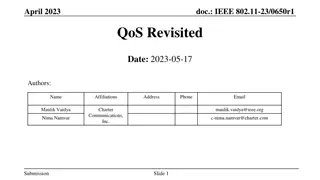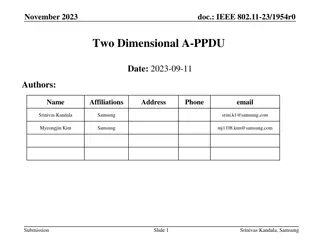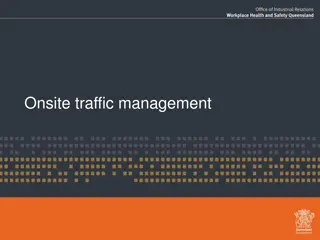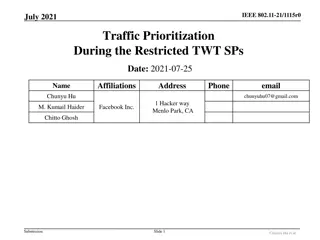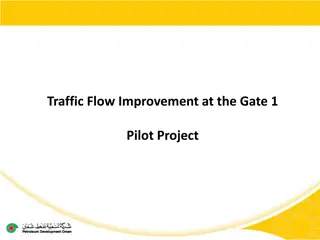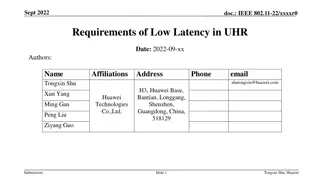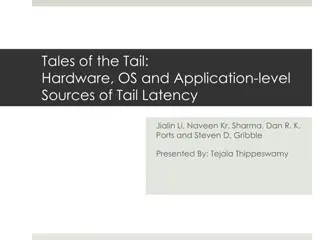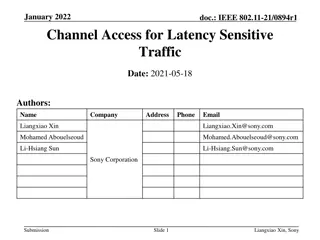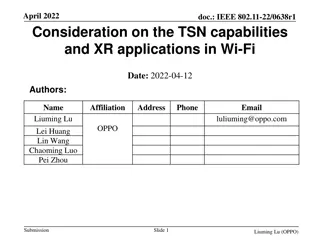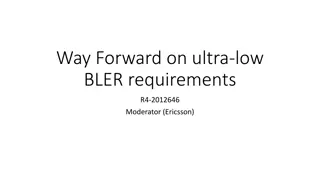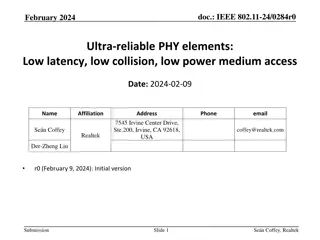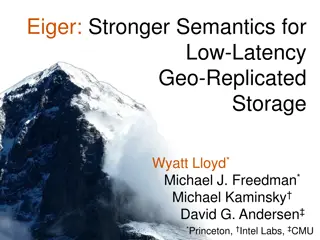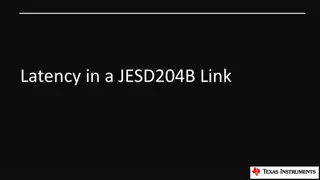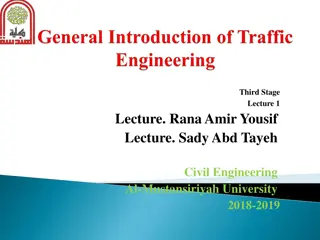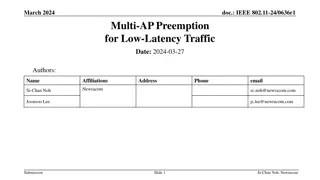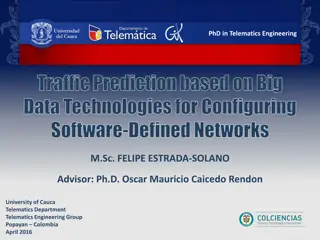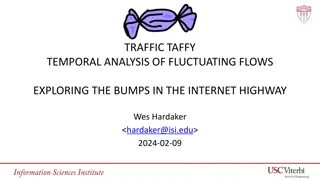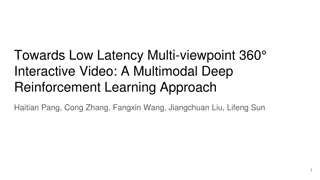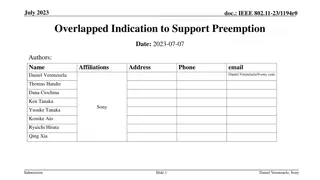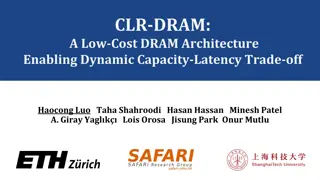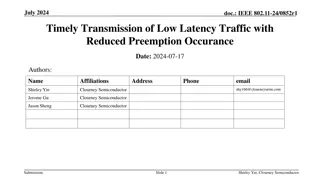Enhancing QoS Facility for Low-Latency High-Throughput Performance in IEEE 802.11 Networks
This proposal addresses the shortcomings in traffic classification and handling of uplink/downlink traffic in current IEEE 802.11 specifications, particularly in relation to low-latency traffic. It also highlights issues with the current EDCA mode in managing congestion and proposes high-level solut
5 views • 18 slides
Enhanced Scheduling Method for Low Latency Traffic in IEEE 802.11-24/0091r1
This document presents an enhanced scheduling method for handling low latency traffic in IEEE 802.11 networks. It focuses on supporting deterministic and event-based latency-sensitive traffic, addressing challenges in scheduling and resource allocation. The proposed method aims to improve the reliab
8 views • 12 slides
Enhancing Low Latency Channel Access in Legacy IEEE 802.11 Networks
This document discusses the impact of introducing a Low Latency (LL) channel access mechanism in legacy IEEE 802.11 networks. It addresses the use of High Priority EDCA (HiP EDCA) mechanisms, proposing solutions for improving tail latency in both isolated BSS and multi-BSS scenarios. Additionally, i
2 views • 10 slides
Two-Dimensional A-PPDU for Low Latency in UHR Networks
This document discusses the proposed two-dimensional (2D) A-PPDU as a solution for supporting low-latency applications in UHR networks. It delves into the details of 2D A-PPDU for downlink, focusing on the ability to insert PPDUs within a PPDU, aiming to reduce latency in UHR environments by enhanci
0 views • 17 slides
Prioritizing Effective Traffic Management at the Workplace
Addressing the importance of traffic management as a top priority issue, the session aims to engage workers in assessing current practices, enhancing traffic management strategies, and improving safety measures to prevent incidents. The discussion focuses on key principles of controlling traffic ris
2 views • 12 slides
Improving Low-Latency Buffer Status Reporting in IEEE 802.11
Proposal for enhancing the Buffer Status Report (BSR) mechanism in IEEE 802.11 to include timing constraints for transmitting latency-sensitive traffic. Suggestions involve adding TSPEC-based signaling and efficient mechanisms for Enhanced Traffic APs to ascertain low-latency traffic status. The cur
0 views • 12 slides
IEEE 802.11-21/1115r0 Traffic Prioritization Summary
The presentation discusses traffic prioritization rules during restricted TWT SPs in IEEE 802.11-21/1115r0. It revisits the topic to address pending items related to traffic restriction or prioritization, including specific rules for APs, scheduled STAs, supporting non-AP STAs, and non-rTWT STAs. Co
1 views • 14 slides
Traffic Flow Improvement at Gate 1 Pilot Project Overview
The Traffic Flow Improvement project at Gate 1 aims to address congestion and safety issues by implementing a one-way traffic flow during peak times. The project involves rerouting traffic, creating designated lanes, and regulating access to optimize traffic movement and reduce the risk of accidents
0 views • 7 slides
Analyzing and Improving Latency in IEEE 802.11 Networks
The document discusses controlling latency in IEEE 802.11 networks to meet the demands of emerging applications that require not only high throughput but also low latency. It covers aspects such as latency analysis, potential improvements, latency vs. reliability trade-offs, and latency improvement
4 views • 14 slides
Evaluation of Low-Latency Services in IEEE 802.11-23/1530r1
This document discusses the evaluation of supported low-latency services in the context of IEEE 802.11-23/1530r1, focusing on the reliability of WLAN, throughput, latency, and MPDU loss. It addresses the challenges in supporting new low-latency services such as AR/VR and industrial IoT, particularly
1 views • 11 slides
Understanding Programmable Traffic Management for Network Optimization
Programmable Traffic Management involves packet scheduling, traffic shaping, policing, drop policies, packet buffering, replication, and classification to optimize network performance. It is used in integrated switch architectures and is crucial for addressing diverse traffic characteristics and req
0 views • 66 slides
Low Latency Requirements in Ultra-High Rate Communication
This document discusses the requirements and use cases of low latency in ultra-high rate communication scenarios, highlighting applications such as metaverse, cloud gaming, real-time video streaming, in-vehicle infotainment, and industrial PLC control. It also covers current methods to reduce latenc
1 views • 12 slides
Luxury Big Island SEO Report - February 2017 Summary
Sessions to the luxury Big Island website decreased by 21% in February 2017, but organic traffic saw an 11% increase attributed to a rise in total organic keywords. Top referrers for the past 6 months indicate Google and direct links drive the majority of traffic. The trend continued in February, wi
0 views • 13 slides
Enhancing Web Search Latency with DDS Prediction
This presentation delves into DDS Prediction, a technique designed to reduce extreme tail latency in web search engines by optimizing query execution times and parallelizing specific queries. It addresses the challenges of improving latency for all users and emphasizes the importance of achieving hi
0 views • 31 slides
Understanding Sources of Tail Latency in Hardware, OS, and Applications
Delve into the impact of latency on revenue, with real-world examples from companies like Amazon and Google. Explore the complexities of achieving low tail latency in large-scale applications and the approach to analyzing and mitigating latency sources at hardware, OS, and application levels.
0 views • 24 slides
Enhancing Channel Access for Latency-Sensitive Traffic in January 2022
In the documentation IEEE 802.11-21/0894r1, the focus is on improving channel access for latency-sensitive traffic through concepts like Restricted TWT (Target Wake Time). The proposal suggests methods to protect TWT Service Periods from non-TWT scheduled STAs, ensuring prioritized transmission of l
0 views • 11 slides
Architecting DRAM Caches for Low Latency and High Bandwidth
Addressing fundamental latency trade-offs in designing DRAM caches involves considerations such as memory stacking for improved latency and bandwidth, organizing large caches at cache-line granularity to minimize wasted space, and optimizing cache designs to reduce access latency. Challenges include
0 views • 32 slides
Engaging Traffic Education Lesson for Students at Shaistagonj Kamil Madrasah
The introduction of Mr. Ariful Islam, a dedicated English lecturer at Shaistagonj Kamil Madrasah in Hobigonj, sets the stage for an interactive lesson on Traffic Education. With a focus on Dhaka city's traffic conditions, the lesson aims to help students identify traffic rules, cross roads carefully
0 views • 26 slides
Impact of Latency on Player Performance in Cloud-based Games
Research conducted by Mark Claypool and David Finkel explores the effects of latency on player performance in cloud-based games. The study compares the impact of latency on both objective (performance) and subjective (quality) measures, highlighting how every 100ms increase in latency results in a 2
0 views • 21 slides
Enhancing Low Latency in IEEE 802.11 Networks
Various mechanisms for low latency in IEEE 802.11 networks are discussed, including C-TDMA, C-RTWT, TXOP Preemption, and HiP-EDCA. This proposal aims to improve initial control frame exchanges to prioritize low latency traffic transmission. By modifying exchange rules and allowing STAs to signal the
0 views • 12 slides
Low-Latency Inter-Datacenter State Machine Replication Using Clock-RSM
Clock-RSM introduces a low-latency approach to inter-datacenter state machine replication by utilizing loosely synchronized physical clocks. This method ensures strong consistency, fault tolerance, and fast failover in a geo-replication environment. By overlapping ordering and replication using phys
0 views • 29 slides
Consideration on TSN Capabilities and XR Applications in Wi-Fi
This contribution evaluates XR applications in Wi-Fi, focusing on high throughput, low latency, and reliability. It discusses in-car XR entertainment/navigation as an entry-level TSN application and proposes integrating Wi-Fi technologies like 11be for improved performance. The document highlights t
0 views • 17 slides
Achieving Bounded Latency in Data Centers: A Comprehensive Study
Data centers face challenges in providing consistent low latencies due to in-network interference and varying workloads. This study explores solutions to guarantee strong latency performance, mitigate latency variance, and minimize performance degradation for latency-sensitive applications. By analy
0 views • 18 slides
Way Forward on Ultra-Low BLER Requirements in Wireless Communication
Explore the agreements and discussions around ultra-low BLER (Block Error Rate) requirements for URLLC (Ultra-Reliable Low Latency Communication) in wireless communication systems. Gain insights into the test methodologies, decision co-ordinates, applicability rules, and open issues related to CQI (
0 views • 9 slides
Ultra-Reliable PHY Elements: Optimized Building Blocks for Low Latency and Efficiency
The document presents a deep dive into ultra-reliable PHY elements, focusing on achieving low latency, reduced collision, and energy efficiency. It proposes optimized universal building blocks to address these goals effectively, especially in scenarios where many devices may not receive transmission
0 views • 17 slides
Stronger Semantics for Low-Latency Geo-Replicated Storage
Discusses the importance of strong consistency and low latency in geo-replicated storage systems for improving user experience and revenue. Various storage dimensions, sharding techniques, and consistency models like Causal+ are explored. The Eiger system is highlighted for ensuring low latency by k
0 views • 24 slides
Understanding Latency Variation in Modern DRAM Chips
This research delves into the complexities of latency variation in modern DRAM chips, highlighting factors such as imperfect manufacturing processes and high standard latencies chosen to boost yield. The study aims to characterize latency variation, optimize DRAM performance, and develop mechanisms
0 views • 37 slides
Latency Measurement in IEEE 802.11 for Low Latency Applications
IEEE 802.11-20/0484r0 discusses the importance of latency measurement for low latency applications in WLAN technologies. The document emphasizes the need for improved worst-case latency and jitter, addressing interference issues to ensure guaranteed latency for scheduled transmissions. Various contr
0 views • 13 slides
Understanding Latency in JESD204B Links
Latency in a JESD204B link refers to the time it takes for a signal to travel from input to output, influenced by factors like system setup, device dependencies, clock propagation delays, and signal alignment. Definitions such as Sample-to-Serial Out (S2SO), Link Delay, and Link Latency are crucial
0 views • 46 slides
Understanding Traffic Engineering Studies in Civil Engineering
Traffic engineering is a crucial aspect of transportation engineering that encompasses planning, design, and operation of roads, streets, and highways. It involves analyzing traffic volume, speed studies, parking patterns, traffic flow characteristics, accident studies, and more. Traffic volume stud
0 views • 37 slides
Multi-AP Preemption for Low-Latency Traffic in IEEE 802.11 Networks
Discussion on the necessity of Multi-AP preemption for low-latency traffic in IEEE 802.11 networks. Addresses issues related to latency-sensitive traffic in overlapping basic service sets (OBSS). Proposes a general solution to enable OBSS APs to transmit urgent low-latency traffic without significan
0 views • 9 slides
PhD in Telematics Engineering: Traffic Prediction with Big Data Technologies
This PhD study focuses on traffic prediction using Big Data technologies within Software-Defined Networking (SDN). It explores the separation of data and control planes in SDN architectures, emphasizing the benefits of centralized control for network operations. Additionally, the study delves into t
0 views • 33 slides
New Queue Mechanism for Real-Time Application Considerations in July 2019
In July 2019, considerations were made for a new queue mechanism for real-time applications. The focus was on improving worst-case latency and jitter for latency-critical traffic, such as in online mobile gaming and manufacturing control. The proposed design aims to link access delay directly to req
0 views • 9 slides
Multi-AP Coordination for Low Latency Traffic Transmission
The document discusses the integration of multi-access point (AP) coordination to enhance the transmission of low-latency traffic in wireless networks. It addresses the challenges and introduces modes of operation capable of reducing latency and improving reliability for low-latency (LL) traffic tra
0 views • 9 slides
Understanding Traffic Education: A Lesson on Traffic Jams and Solutions
Join Mr. Ariful Islam in his English class for Alim 1st year students as he introduces the topic of Traffic Education. Through warm-up activities and reading Michael Hobbes' article on traffic challenges in Dhaka, Bangladesh, students explore the causes of traffic jams and envision solutions to impr
0 views • 23 slides
Exploring Traffic Anomalies with Traffic Taffy: Network Operators' Challenges
Discover how network operators tackle odd anomalies in internet traffic with Traffic Taffy, a tool that aids in temporal analysis of fluctuating flows. Current solutions and specific problem spaces are discussed, alongside insights for comparing anomalies against baselines and defining the problem s
0 views • 24 slides
Low Latency Multi-viewpoint 360 Interactive Video System with Deep Reinforcement Learning
This research focuses on addressing the challenges of achieving low latency and high quality in multi-viewpoint (MVP) 360 interactive videos. The proposed iView system utilizes multimodal learning and a Deep Reinforcement Learning (DRL) module to optimize tile selection, aiming to reduce latency and
0 views • 17 slides
Overlapped Indication for Event-Based Low Latency Traffic Support in IEEE 802.11
The document discusses the importance of reducing latency in Ultra High Rate (UHR) PAR and Event Based Low Latency (LL) traffic support in IEEE 802.11 networks. It introduces the concept of preemption to enhance LL traffic handling and proposes an overlapped LL indication frame to address challenges
0 views • 13 slides
CLR-DRAM: Dynamic Capacity-Latency Trade-off Architecture
CLR-DRAM introduces a low-cost DRAM architecture that enables dynamic configuration for high capacity or low latency at the granularity of a row. By allowing a single DRAM row to switch between max-capacity and high-performance modes, it reduces key timing parameters, improves system performance, an
0 views • 42 slides
IEEE 802.11-24/0852r1: Timely Transmission of Low Latency Traffic with Reduced Preemption Occurrence
This document discusses the challenges of ensuring timely transmission of low-latency traffic while minimizing preemption occurrences in IEEE 802.11 networks. It addresses issues related to operating modes, preemption mechanisms, and the impact on user experience. The submission proposes solutions t
0 views • 9 slides
